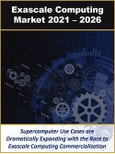Supercomputer Use Cases are Dramatically Expanding with the Race to Exascale Computing Commercialization
Speak directly to the analyst to clarify any post sales queries you may have.
Select Report Findings:
- The global exascale hardware market will reach $7.7 billion by 2026
- Government and defense will remain the largest segments through 2026
- Key verticals include bioscience, finance, and electronic design automation
- AI solutions are broadening the reach of exascale to increasingly smaller users
- Exascale-level HPC will be very important for autonomous vehicle data analytics
Exascale computing takes High-Performance Computing (HPC) to a level of computational ability in the range of quintillion calculations per second. This degree of performance is necessary to solve very complex problems such as climate research, oil and gas exploration, molecular modeling, and physical simulations. Accordingly, the exascale computing market is currently driven by demands by a few businesses and governmental entities that require intensive number crunching for very specific problems.
Well-suited for applications that require high-performance data analysis, the exascale computing market supports a variety of apps such as high-frequency trading, autonomous vehicles, and genomics-based personalized medicine, computer-aided design, and deep learning.
Some specific solution areas within science and technology include computational fluid dynamics, advanced simulations, complex system modeling, and advanced imaging analysis such as seismic tomography. Most of the initial applications have been within the realm of large corporations and government-funded initiatives.
With the goal to launch a USA-led exascale ecosystem this year, the DOE-driven Exascale Computing Project is looking to increase computing power by 50 times current system capabilities. This project is intended to tip the scales in favor of the United States in terms of economic competitiveness as well as national security by enabling breakthroughs in scientific discovery and technological innovation such as cybersecurity. Accordingly, the National Nuclear Security Administration is one of the partners in this initiative.
While traditionally within the domain of government and large corporations, the exascale computing market will become increasingly more accessible to a broad range of companies with a corresponding wider range of applications. For example, exascale-level processing will be a critical component for processing data from millions of self-driving vehicles as part of an intelligent transportation system that optimizes traffic flow and utilization of vehicular resources. The exascale computing market will also become increasingly available to small businesses and engineering teams as artificial intelligence is leveraged to help engineers better leverage supercomputers.
Exascale-level computing is anticipated to become a more mass-market as computing costs continue to decrease and flexible deployment options are introduced. This research anticipates that the Exascale Computing Market will expand dramatically as cloud-based solutions are implemented to allow for HPC as a Service (HPCaaS).
Small to medium-sized businesses will benefit greatly from the HPCaaS model as they may utilize exascale-level computing on an on-demand basis for the duration of a project. Exascale-level HPC will be very important for certain consumer-oriented applications and services.
Target Audience:
- ICT service providers
- Governments and NGOs
- Security solution providers
- ICT infrastructure providers
- Digital commerce companies
- Data and computing companies
With the purchase of this report at the Multi-user License or greater level, you will have access to one hour with an expert analyst who will help you link key findings in the report to the business issues you're addressing. This will need to be used within three months of purchase.
This report also includes a complimentary Excel file with data from the report for purchasers at the Site License or greater level.
Table of Contents
1 Executive Summary
2 Introduction
2.1 Next Generation Computing
2.2 High Performance Computing
2.3 Supercomputers
2.3.1 Super Computing
2.3.2 Exascale Computing Development
2.3.3 Exascale Use Cases and Application Areas
2.3.4 Regulatory Framework
2.3.5 Value Chain Analysis
3 Exascale Computing Market Analysis and Forecasts 2021 - 2026
3.1 Exascale Computing Market by Component
3.2 Exascale Computing Market by Hardware Type
3.3 Exascale Computing Market by Service Type
3.4 Exascale Computing Market by Industry Vertical
3.5 Exascale Computing as a Service
4 High Performance Computing Company Analysis
4.1 Vendor Ecosystem
4.2 Leading Companies
4.2.1 Amazon Web Services Inc.
4.2.2 Atos SE
4.2.3 Advanced Micro Devices Inc.
4.2.4 Cisco Systems
4.2.5 DELL Technologies Inc.
4.2.6 Fujitsu Ltd
4.2.7 Hewlett Packard Enterprise
4.2.8 IBM Corporation
4.2.9 Intel Corporation
4.2.10 Microsoft Corporation
4.2.11 NEC Corporation
4.2.12 NVidia
4.2.13 Rackspace Inc.
5 Conclusions and Recommendations
Figures
Figure 1: Global Exascale Computing as a Service Market 2021 - 2026
Figure 2: AWS Serverless Architecture
Figure 3: AWS Lambda Work Process
Figure 4: PRIMEFLEX HPC Architecture
Figure 5: Microsoft Azure Serverless Architecture
Figure 6: Hybrid HPC Architecture
Figure 7: Rackspace HPC Cloud Architecture
Tables
Table 1: Global Exascale Computing Driven HPC Market by Component 2021 - 2026
Table 2: Global Exascale Computing Driven HPC Market by Hardware Type 2021 - 2026
Table 3: Global Exascale Computing Driven HPC Market by Service Type 2021 - 2026
Table 4: Global Exascale Computing Driven HPC Market by Industry Vertical 2021 - 2026
Table 5: Global Exascale as a Service Market by Industry Vertical 2021 - 2026
Companies Mentioned
- Advanced Micro Devices
- Amazon Web Services
- Atos
- Cisco Systems
- Cray Inc.
- DELL Technologies Inc.
- Fujitsu Ltd
- Hewlett Packard Enterprise
- IBM Corporation
- Intel Corporation
- Lenovo Group Ltd
- Microsoft Corporation
- NEC Corporation
- NVidia
- Rackspace US Inc.
Methodology

LOADING...








